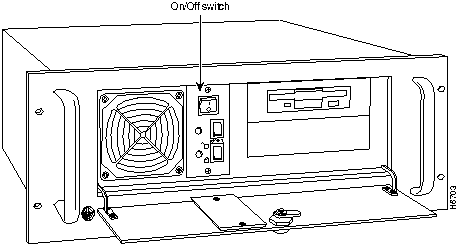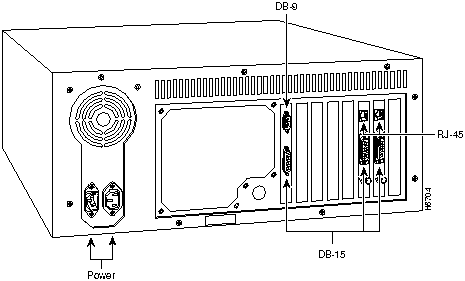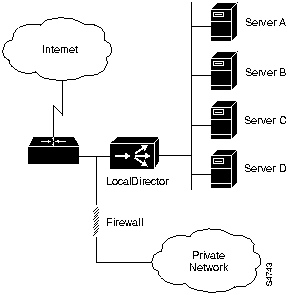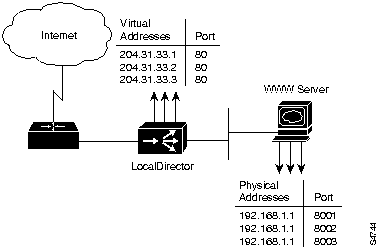|
|
This chapter provides information on the Cisco LocalDirector product. The information is organized into the following sections:
Cisco Systems' LocalDirector meets the demands of high-volume TCP/IP traffic by allowing multiple servers---even a collection of heterogeneous hardware and operating systems---to appear as a single IP address. LocalDirector's Session Distribution Algorithm (SDA) allocates connections to the currently highest-performing server in the network. The resulting redundancy and performance assure unprecedented levels of user service.
LocalDirector also allows World Wide Web (WWW) service providers to transparently support multiple domain addresses from a single server, freeing up resources and improving network flexibility. Combine this functionality with the SDA session distribution capability to scale your system seamlessly while taking full advantage of intelligent load balancing.
LocalDirector is fast---over 45 Mbps throughput. Simple setup with no network address changes frees up valuable system administration time. LocalDirector meets the major challenges in extending local Internet services in a manageable and scalable manner.
Figure 152 : Cisco LocalDirector Front View

Figure 153 : Cisco LocalDirector Rear View


Cisco LocalDirector includes the following features:
TCP Across Multiple Servers: Inverse Multiplexing Mode
Cisco solves the TCP-across-multiple-servers problem by using LocalDirector's inverse multiplexing mode (IMM) to present the appearance of a single server to the outside, while actually using the power of multiple servers (see Figure 154).
Figure 154 : Inverse Multiplexing Mode Example

LocalDirector supports multiple IMM groups. Each IMM group consists of a virtual address multiplexed to many real servers each with a real IP address. LocalDirector measures the load on the servers specified in the IMM groups and intelligently distributes the load among those servers. In this way, LocalDirector provides nearly linear scalability.
LocalDirector is a transparent device---servers behind LocalDirector are accessible using their real IP addresses. Only the connections made to the virtual addresses (using IMM) are distributed. It is this virtual address that is assigned to the Domain Naming System (DNS). This is important because many client software applications cache the DNS entry for extended periods.
LocalDirector measures how well the server is providing service to the clients and uses this information to distribute connections to the server that are best able to serve the client using the session distribution algorithm (SDA).
In the SDA example shown in Table 323, four servers with different performance capabilities are located behind LocalDirector in a configuration similar to the one shown in Figure 154.
Table 323 : Session Distribution Algorithm Example
| Server | IP Address | Performance Index (at idle) | Server Type |
|---|---|---|---|
| A | 192.1.1.1 | 10 | Intel P5---IDE disk |
| B | 192.1.1.2 | 20 | Intel P6---SCSI disk |
| C | 192.1.1.3 | 30 | SGI---SCSI disk |
| D | 192.1.1.4 | 30 | SGI---SCSI disk |
Servers C and D have similar response times as measured by the SDA. Connection requests are fed primarily to servers C and D (the highest-performance servers) sequentially until their performance indexes degrade to less than 20. At this point, the SDA assigns more connections to server B. With increased load, the performance index for B degrades along with that for C and D. The SDA continuously monitors response times, network utilization, and application mix to ensure that connections are allocated to the highest-performance server. When the performance indexes of servers B, C, and D fall below 10, server A begins to take connections.
When a server fails, the SDA notices the long response time and re-routes pending connections to healthy servers. The SDA checks the failed server periodically, and when the server returns, begins to issue connections again.
Serving Multiple Domains from One Server: Forward Multiplexing Mode
LocalDirector solves the multiple-domains-from-one-server problem by enabling forward multiplexing mode (FMM). Under FMM, LocalDirector allocates multiple virtual addresses mapped to a single server using multiple TCP ports. Figure 155 illustrates this capability.
Figure 155 : Forward Multiplexing Mode Example

In this example, a single server (192.168.1.1) runs multiple Web server processes, each residing on a different TCP port. The outside world, however, sees the virtual addresses for three separate servers.
LocalDirector allows administrators to scale this configuration by specifying multiple sets of IMM groups. Additionally, administrators can specify the physical addresses in groups to take advantage of load balancing, as described for IMM.
Cisco LocalDirector includes the following additional benefits:

Table 324 lists the product numbers for Cisco LocalDirector.
Table 324 : Cisco LocalDirector Product Numbers
| Description | Product Number |
|---|---|
| Cisco LocalDirector | CA-LDIR |
| 2 10/100 Ethernet interfaces | NI-2FE |
| 2 10/100 Ethernet interfaces | NI-2FE= |
| Standard cord options | CAB-AC
CAB-ACE CAB-ACI CAB-ACU CAB-ACA |
| Cisco LocalDirector software | SW-LDIR |
| Cisco LocalDirector software version update | SW-LDIR-VER= |
| Cisco LocalDirector SMARTnet maintenance | CON-SNT-LDIR |
|
|
Copyright 1988-1996 © Cisco Systems Inc.